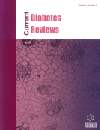-
s Visceral Adiposity Measurements, Metabolic and Inflammatory Profi le in Obese Patients with and Without Type 2 Diabetes Mellitus: A Crosssectional Analysis
- Source: Current Diabetes Reviews, Volume 13, Issue 1, Feb 2017, p. 11 - 18
-
- 01 Feb 2017
Abstract
Introduction: Waist circumference does not distinguish subcutaneous from visceral adipose tissue, which is highly associated with impaired cardiometabolic profile and type-2 diabetes mellitus (T2DM). Because of the complexity of the assessment of visceral fat with imaging techniques, easy-to-apply and low-cost anthropometric measures have been proposed. The aim of the study was to show a possible association between Lipid Accumulation Product Index (LAP Index), Deep-abdominal adiposity tissue Index (DAAT) and Visceral Adiposity Index (VAI) with metabolic profile and adipokines in obese subjects with and without T2DM, and to compare the results with the use of waist circumference isolated. Methods: In this cross-sectional study, we enrolled 101 outpatients with obesity (BMI ≥ 30 kg/m2) of which 48% with diabetes and aged 48.9 ±13.3 years. Demographic, clinical and anthropometric data were collected. Plasma C-reactive protein, interleukin-6, vascular adhesion molecule type 1 and adiponectin levels, lipid profile and fasting glucose were assessed. LAP Index, DAAT and VAI were calculated and body composition was evaluated by bioelectric impedance analyses. Continuous variables were described as mean ±standard deviation, and categorical variables as absolute numbers and percentages. Nonparametric data were log-transformed and Student’s t test, Wilcoxon-Mann-Whitney and chi-squared test, Pearson correlation and multiple linear regression were used for statistical analyses. Results: In total, 31 men and 70 women were evaluated. Individuals with T2DM showed higher LAP values and percentage of body fat and lower waist circumference and BMI values. DAAT and LAP were positively correlated with BMI, waist circumference, percentage of body fat and free fat mass. After adjustment for age, sex and total body fat, both LAP Index and VAI were associated with plasma adiponectin, LDL-cholesterol, non-HDL cholesterol and VLDL-cholesterol in obese with and without T2DM (all P values ≤ 0.02); fasting glucose remained associated with LAP in obese patients without T2DM (P= 0.01). Waist circumference only correlated with adiponectin in obese subjects without T2DM (P= 0.048). Conclusions: Our data suggest that VAI and LAP Index are good predictors of an impaired cardiometabolic setting in obesity regardless of T2DM status. Besides, we were not able to find associations with waist circumference and biochemical markers in our sample.


